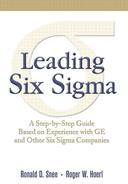The W.R. Grace Story
W. R. Grace presents an interesting contrast to GE in terms of Six Sigma success. While GE is a massive (about $130 billion in revenue), internationally known company, Grace is a much smaller and lower profile company. Some analysts have hypothesized that size is a key component to Six Sigma success; that it is an initiative that only works for large companies. As we shall see more clearly, this is not the case, and Grace provides an excellent illustration.
Grace is an international specialty chemical and materials company with about $2 billion in revenues. Its main businesses are catalysts, construction chemicals (fireproofing, waterproofing, concrete admixtures, etc.), coatings/sealants, and silicas/adsorbents. While it entered Chapter 11 protection in April 2001 because of previous asbestos-related lawsuits, the financial performance from operations has been good. The primary reason Grace adopted Six Sigma was that CEO Paul Norris had been involved in the Six Sigma effort at AlliedSignal, prior to coming to Grace. Norris had seen what Six Sigma could do, and was determined to achieve similar improvements at Grace.
Grace began its Six Sigma initiative in 1999, shortly after Norris arrived, utilizing Sigma Breakthrough Technologies Incorporated (SBTI) as its provider. The company held its first executive workshop in August 1999, quickly followed by three waves of Champion workshops (for each major business), two of which were held in Europe. The Grace leadership team developed a deployment plan at an executive workshop, and identified critical projects at the Champion workshops. These projects were selected primarily because of their anticipated financial payoff. Grace named a Six Sigma leader for each business, with overall accountability for implementation.
The Six Sigma leader put the deployment plan into effect, which led to three waves of Black Belt training, in 1999, 2000, and 2001. The Black Belts, which were in both the U.S. and European operations, initially implemented the projects selected during the Champion workshops. Champions held weekly project reviews, and business VPs held monthly reviews. CEO Paul Norris held quarterly reviews to monitor the overall progress of the implementation. Initially one MBB supported the company, and this has evolved into one MBB for the catalyst and silicas/adsorbents business and three MBBs in the construction products business. All the MBBs and Black Belts were freed up to work on Six Sigma full time. The people put into these roles were generally viewed as top performers. Grace put a reward and recognition system in place early in the initiative to reinforce the contributions of the Black Belts, Green Belts, and project team members. In early 2001, an Internet-based project tracker was developed to better monitor the status and impact of each project. As per the deployment plan, Grace added additional training and types of projects over time, as depicted in the following list—
Began six waves of DFSS training in November 2000 in Europe and the US, to bring Six Sigma to the R&D function. The program was aligned with the current Grace development system, linking specific tools to the various stage gates.
Began holding waves of Green Belt training for non-manufacturing operations in February of 2001
Held an advanced Black Belt workshop in February 2001.
Began holding waves of “Yellow Belt” training for process operators, primarily focused on the measure phase, in June 2001.
Held the first Green Belt course in Asia in July 2001.
Began Green Belt training tailored to Finance in October 2001.
Developed specific in-house training for Catalyst Technical Service professionals, who work throughout refineries and chemical plants around the world, in the first quarter of 2002.
Developed in-house analytical Green Belt training that focuses on running and evaluating measurement systems in 2002
At the end of 2000, Grace had formally completed about 80 projects. It had about 40 Black Belts and 80 Green Belts. The company documented a financial impact of $26 million in hard savings, and another $7 million in cost avoidance. While $26 million may not sound like a lot relative to the numbers published by GE, it represents a higher percentage of both total revenues and profits than GE's published savings in any year to date! Clearly, Six Sigma was working quite well for a much smaller company.
By the end of 2001, the catalysts and silicas/adsorbents business alone had about 50 Black Belts, almost 200 Green Belts, and almost 500 Yellow Belts (process operators trained primarily in the measure phase methods). By the first quarter of 2002 this business had completed over 100 projects, with many more than this in progress. Grace's 2001 results came in even better than 2000 with $50 million in hard savings, and $9 million in cost and capital avoidance.
